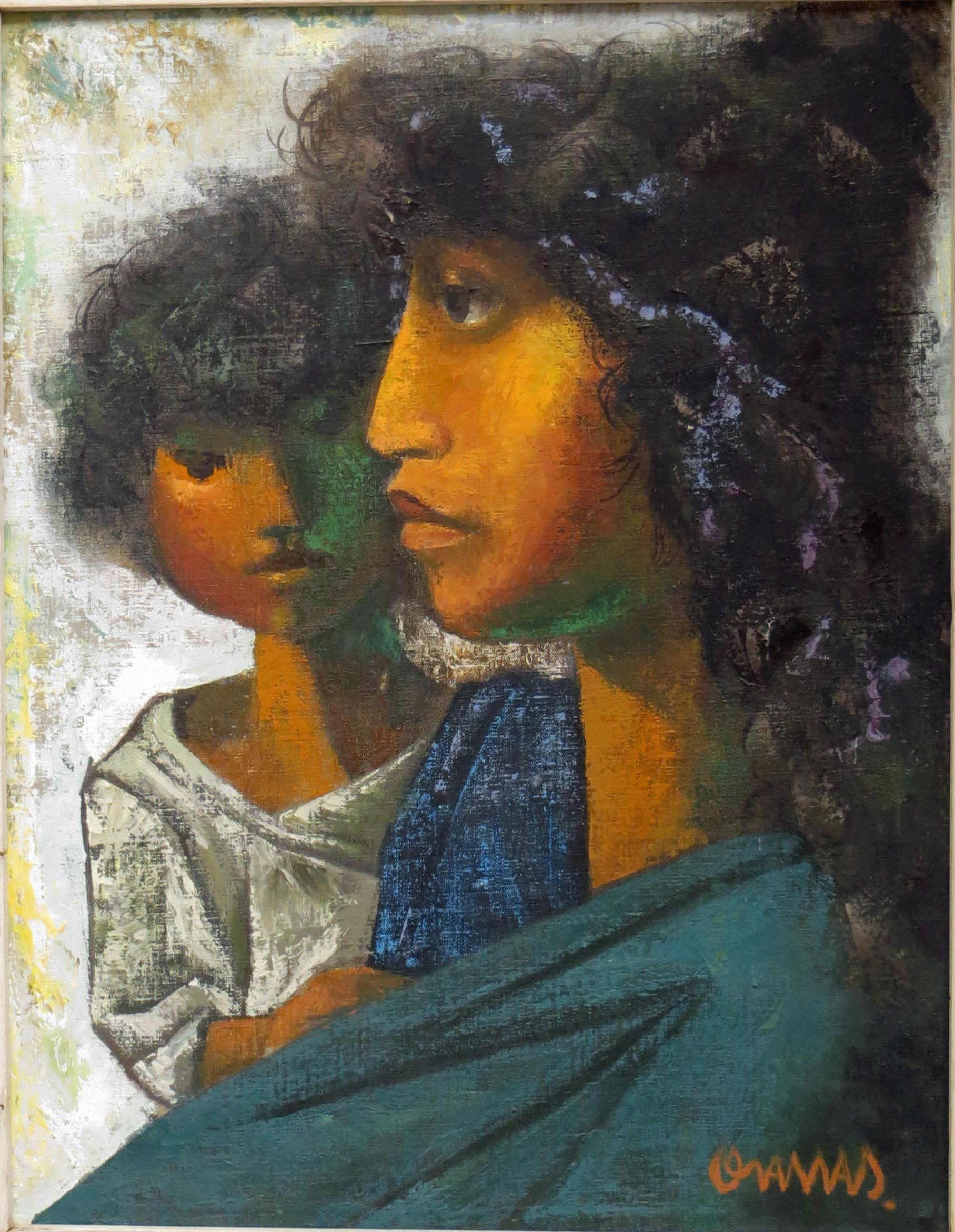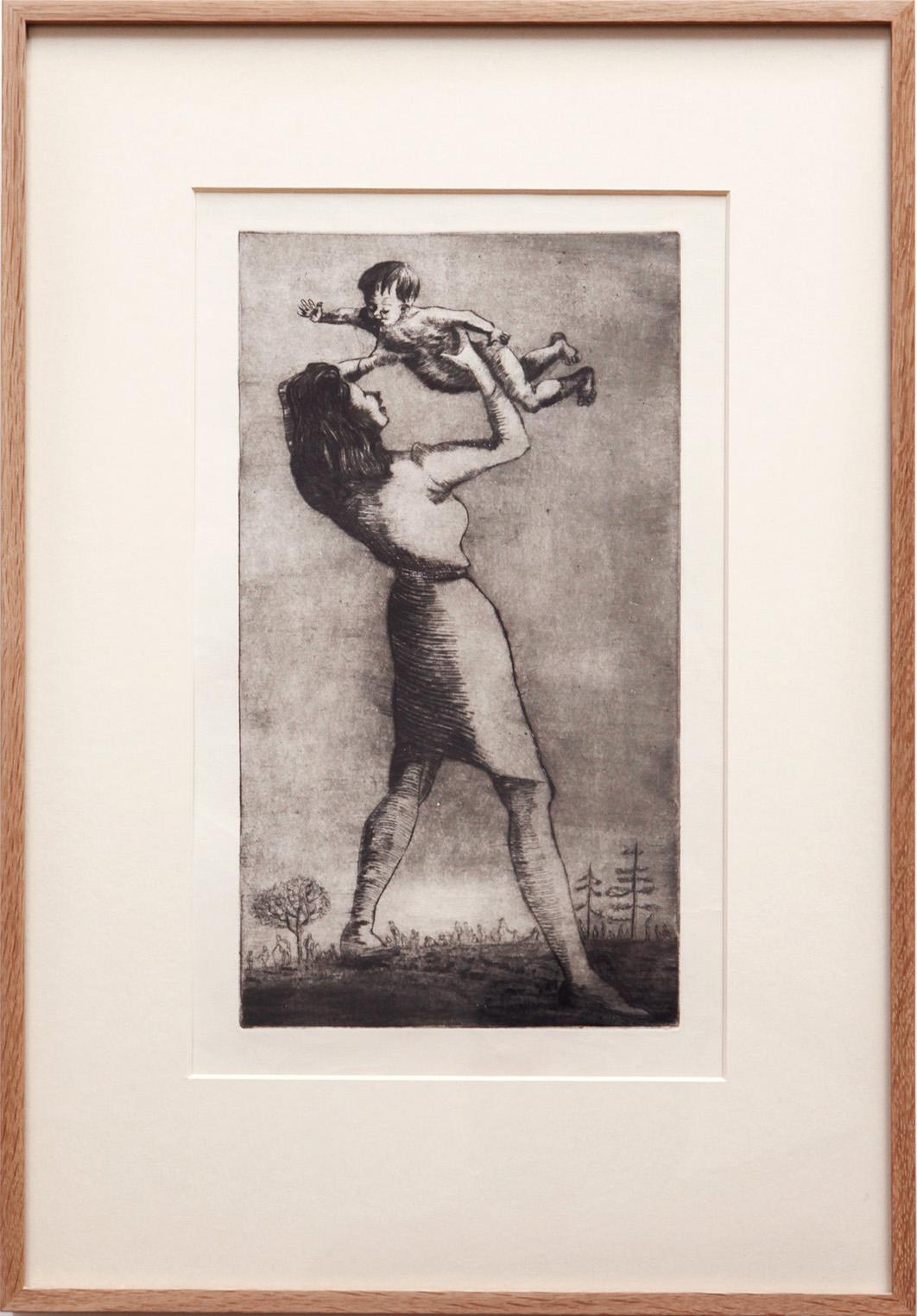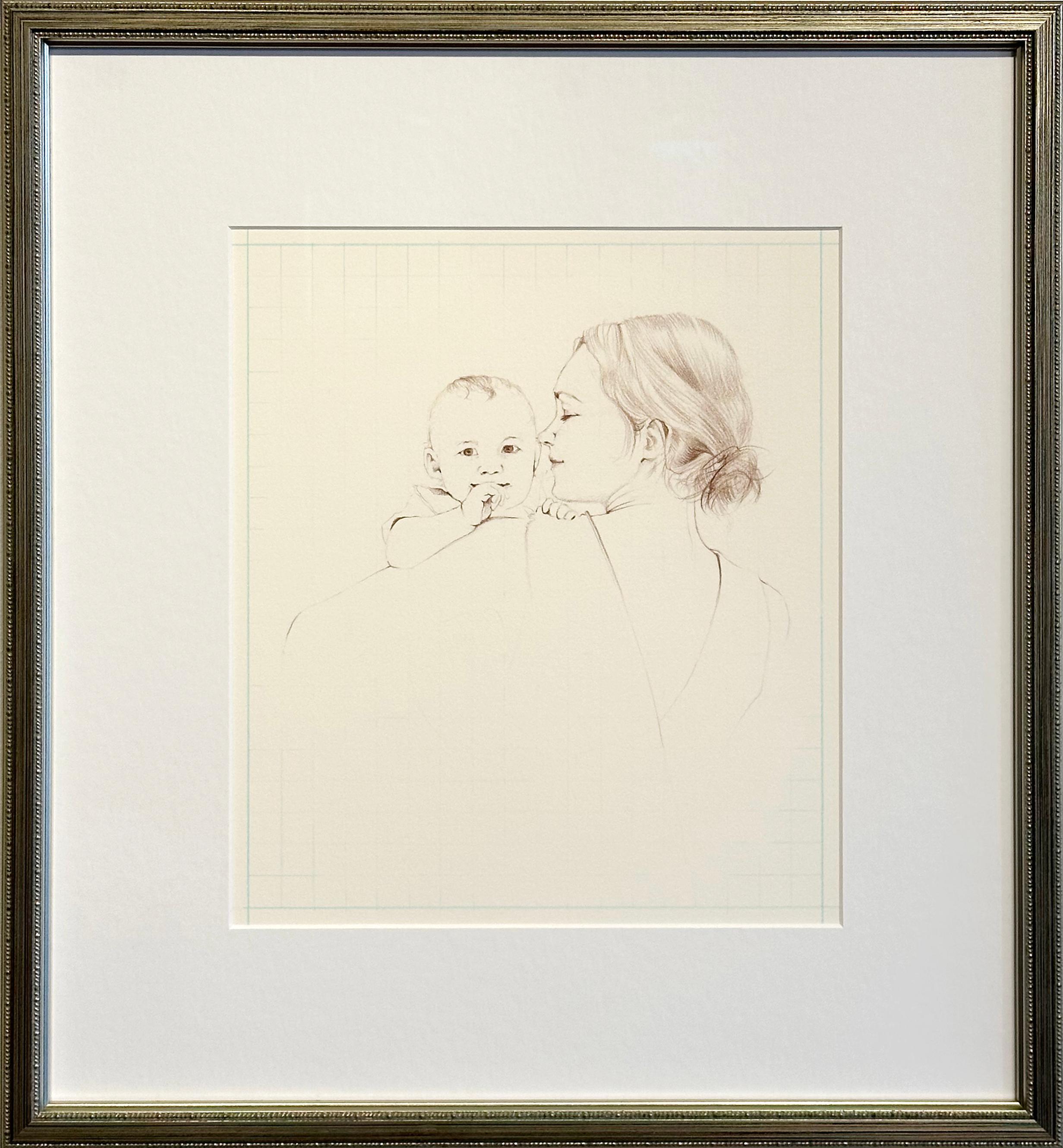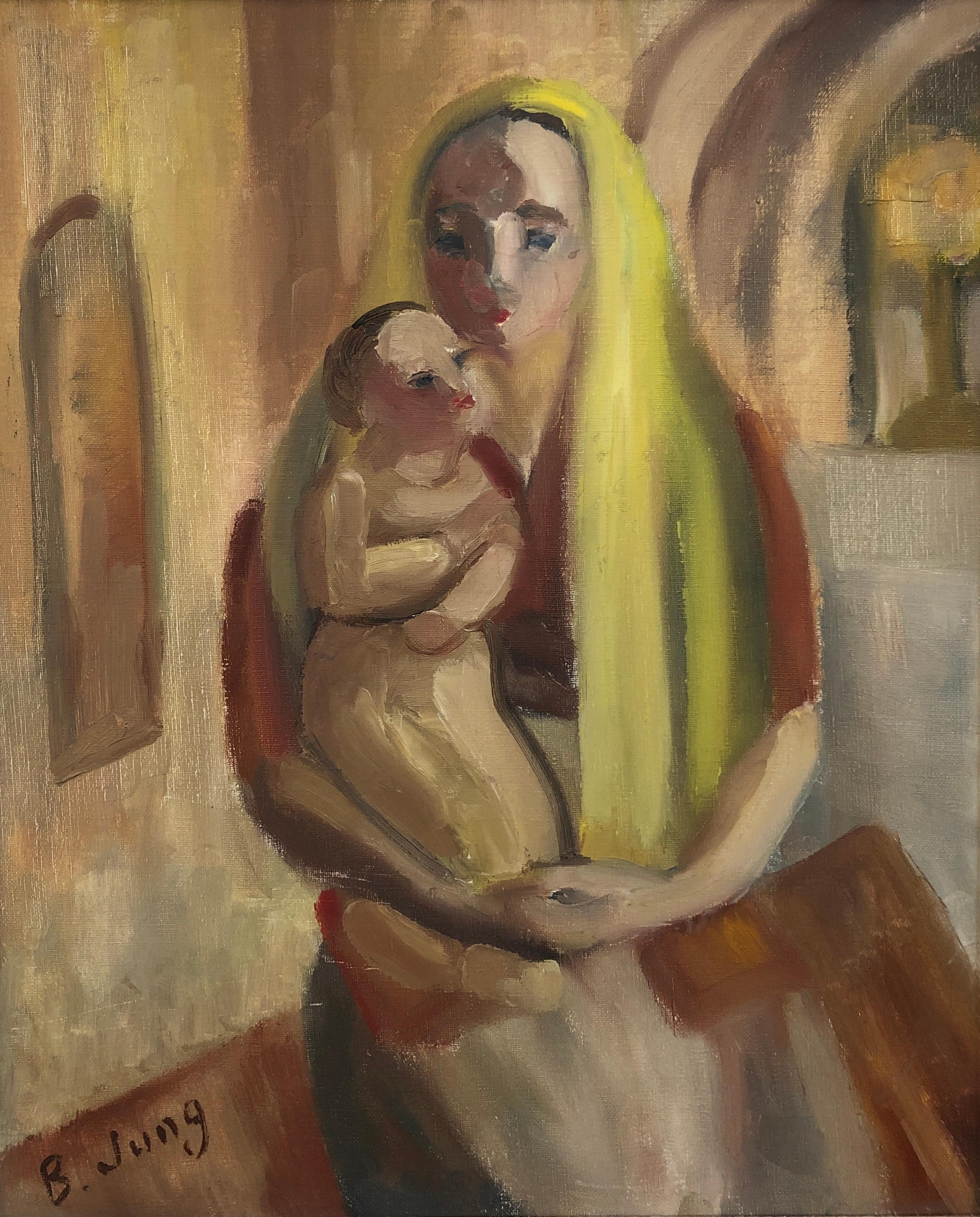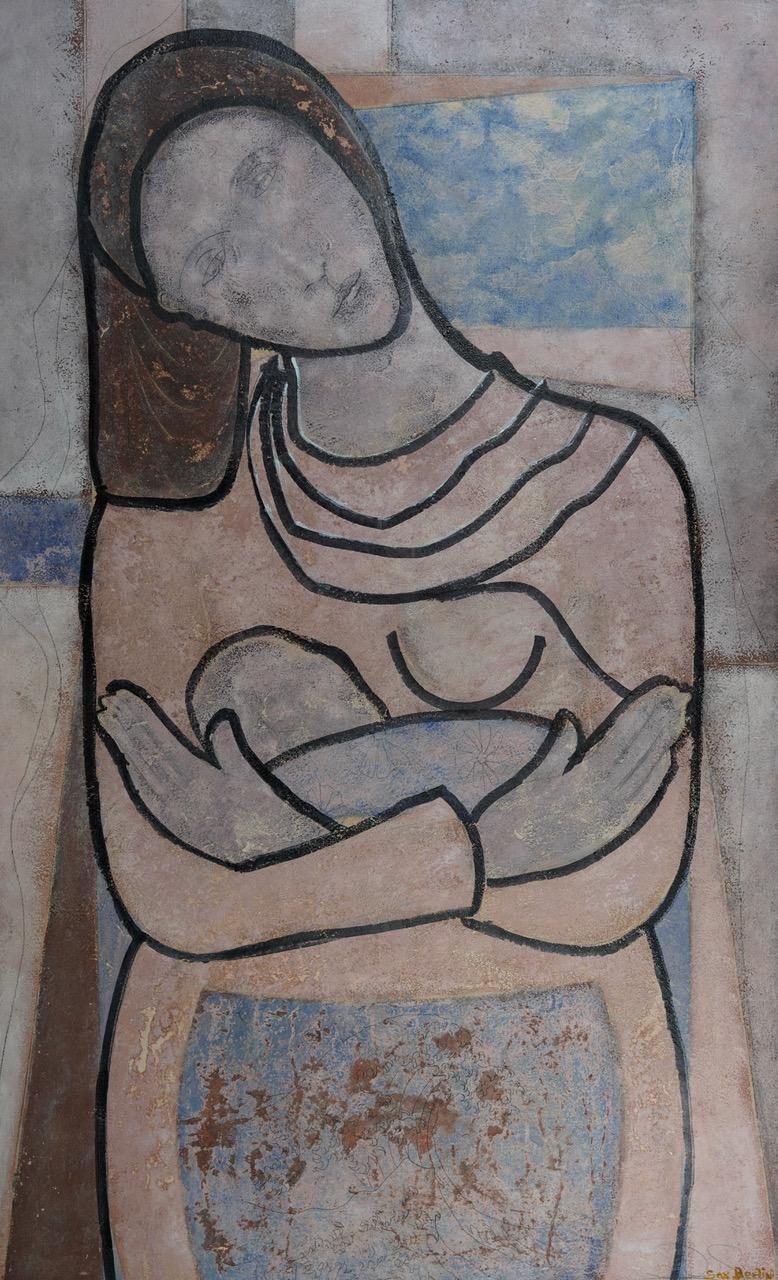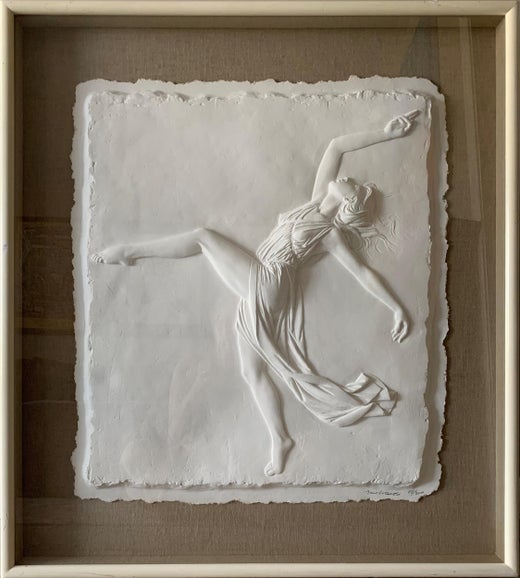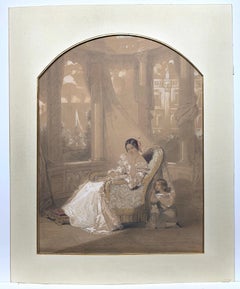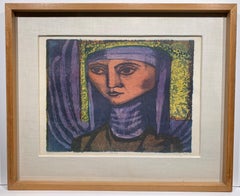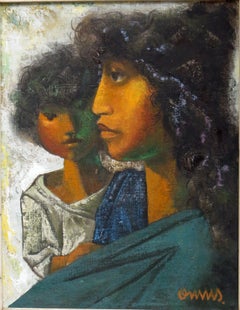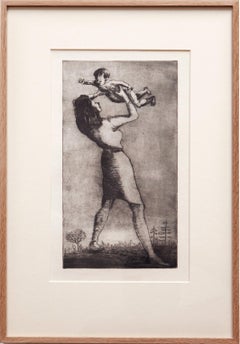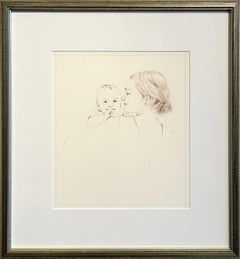Want more images or videos?
Request additional images or videos from the seller
1 of 9
Bruno LucchesiMother and Childca. 1960
ca. 1960
$560
$70020% Off
£422.62
£528.2720% Off
€483.83
€604.7920% Off
CA$789.79
CA$987.2320% Off
A$867.09
A$1,083.8620% Off
CHF 452.36
CHF 565.4520% Off
MX$10,492.95
MX$13,116.1920% Off
NOK 5,669.64
NOK 7,087.0520% Off
SEK 5,342.29
SEK 6,677.8620% Off
DKK 3,611.68
DKK 4,514.6020% Off
About the Item
Bruno Lucchesi (b.1926). Mother and Child, ca. 1960. Oil and charcoal on sized paper mounted to masonite, measuring 11 x 21 inches; 15.5 x 25.5 inches in original gold leaf frame. Signed lower right. Excellent condition.
Born in 1926 in the village of Fibbiano Montanino, Lucca, Italy, Bruno Lucchesi has been called "the last of the Renaissance sculptors." As a boy, he worked as a shepherd, his first artistic imaginings demonstrated in designs he would carve out of sticks while tending the sheep. At ten years old, he left his home village to study at a monastery in Lucca, where he had his first exposure to sculpture as an art form.
After a few years, he returned home to work on the family farm, throughout the Second World War. During this time he met a Yugoslavian refugee artist, who took Lucchesi under his wing, teaching him the basics of drawing and encouraging him to pursue more formal training. Lucchesi did so, enrolling in the Art Institute of Lucca in 1947, and completing the classical training there in 1950. Subsequently, the twenty-four-year-old Lucchesi moved to Florence and continued to study sculpture, working for the Paternino Reproduction Company, where he made ceramic models of various types of figures for the tourist trade and invented a new technique termed sfoglia, used for creating realistic folds and texture in clothing.
He was appointed assistant professor of architecture at the Art Academy in Florence and so began a teaching career, which would continue in the United States, at the New School for Social Research and the National Academy of Design.
It was 1958 when Lucchesi, with his young wife and child, moved to New York City where his wife's parents lived. In his first year in America, Lucchesi worked a variety of jobs, finding little time for his own work and a scarcity of commission opportunities available. He took to making small sculptures in his spare time, which he began selling through his father-in-law's frame shop in Greenwich Village. His work soon found a faithful group of followers and he began to earn his living from sales of his artwork.
In 1959, Lucchesi won the Helen Foster Barnett Prize for Sculpture from the National Academy of Design and the following year had his sculpture "The Bather" selected for inclusion in the Whitney Annual, an annual exhibition of contemporary painting and sculpture at Whitney Museum of American Art. He returned to Florence, to focus exclusively on his work for one year, coming back to New York City in 1961 to a one-man show at the newly-opened Forum Gallery. His relationship with Forum Gallery would continue for the next several decades, with a total of nine solo exhibitions during that time span.
1962 brought Lucchesi a Guggenheim fellowship (1962-1963) and his first U.S. commission for a frieze at the National Westminster Bank USA of New York. The following decades included a succession of awards and prominent commission work, including four Gold Medals for sculpture: two from the National Academy of Design (1970, 1974), one from the National Arts Club (1963) and another from the National Sculpture Society (1977).
Commissioned sculptures by Bruno Lucchesi can be found at churches in Lucca, Italy, office buildings in Manhattan and various other locations throughout the U.S. and Italy. His work is included in the following collections: Brooklyn Museum, Brooklyn, NY; Columbia Museum, Columbia, South Carolina; Cornell University, Ithaca, NY; Dallas Museum of Art, Dallas TX; Hirshhorn Museum and Sculpture Garden, Smithsonian Institution, Washington, D.C.; National Academy of Design, New York, NY; Pennsylvania Academy of the Fine Arts, Philadelphia, PA; Utah Museum of Fine Arts, Salt Lake City, UT; and the Whitney Museum of American Art, New York, NY, among others.
- Creator:Bruno Lucchesi (1926, American)
- Creation Year:ca. 1960
- Dimensions:Height: 25.5 in (64.77 cm)Width: 15.5 in (39.37 cm)Depth: 1.5 in (3.81 cm)
- Medium:
- Movement & Style:
- Period:
- Condition:
- Gallery Location:Wilton Manors, FL
- Reference Number:1stDibs: LU245212458492
Bruno Lucchesi
Bruno Lucchesi was born in Fibbiano Montanino in Lucca, Italy, in 1926. He is an Italian-American sculptor known for his figurative work.. He studied at the Art Institute of Lucca, then moved to Florence, Italy, where he became an assistant professor at the University of Florence in 1953. In 1958, he moved to New York City and has since taught there at the National Academy of Design and the New School of Social Research. He continues to teach through workshops across the United States and Europe.
About the Seller
4.9
Platinum Seller
Premium sellers with a 4.7+ rating and 24-hour response times
Established in 2007
1stDibs seller since 2015
420 sales on 1stDibs
Typical response time: 2 hours
- ShippingRetrieving quote...Shipping from: Wilton Manors, FL
- Return Policy
Authenticity Guarantee
In the unlikely event there’s an issue with an item’s authenticity, contact us within 1 year for a full refund. DetailsMoney-Back Guarantee
If your item is not as described, is damaged in transit, or does not arrive, contact us within 7 days for a full refund. Details24-Hour Cancellation
You have a 24-hour grace period in which to reconsider your purchase, with no questions asked.Vetted Professional Sellers
Our world-class sellers must adhere to strict standards for service and quality, maintaining the integrity of our listings.Price-Match Guarantee
If you find that a seller listed the same item for a lower price elsewhere, we’ll match it.Trusted Global Delivery
Our best-in-class carrier network provides specialized shipping options worldwide, including custom delivery.More From This Seller
View AllIkon
Located in Wilton Manors, FL
Harry Sefarbi (1917-2009)
Ikon, ca. 1980.
Oil on panel, 5.25 x 16 inches. Framed measurement: 8.25 x 19 inches.
Signed lower right. Accompanied by 3 pieces of paperwork.
The A...
Category
Mid-20th Century Abstract Figurative Paintings
Materials
Oil
Mother and Child
Located in Wilton Manors, FL
Beautiful original painting by French artist, Alexandre de Valentini (1787-1887). Pencil and gouache on paper, 14 x 18.5 inches; 19 x 23.5 inches matted. Signed and dated with Paris...
Category
Mid-19th Century Academic Interior Paintings
Materials
Gouache, Pencil
$960 Sale Price
61% Off
Untitled (Abstract Expressionist Painting)
Located in Wilton Manors, FL
Max Schnitzler (1903-1999).
Untitled, ca. 1950's
Oil on canvas measuring 18 x 24 inches.
Unframed.
Minor area of paint loss at margin upper left.
Category
Mid-20th Century Abstract Abstract Paintings
Materials
Oil
Malach
By Jerome Kaplan
Located in Wilton Manors, FL
Jerome Kaplan (1920-1997). Malach (Angel), 1952. Lithograph on wove paper. Image measures 15 x 19 inches; 23 x 28 inches in custom shadowbox frame with custom beveled linen matting. ...
Category
Mid-20th Century Abstract Abstract Prints
Materials
Lithograph
$400 Sale Price
20% Off
Woman Walking Dog
By Graciela Rodo Boulanger
Located in Wilton Manors, FL
Circle of Graciela Rodo Boulanger.
Woman Walking Dog, ca. 1970.
Oil on wood panel measuring 5 x 7 inches; 12.25 x 14.25 inches framed.
Signed indistinctly upper right.
Category
Mid-20th Century Abstract Figurative Paintings
Materials
Oil, Wood Panel
Portrait of a Young Woman
Located in Wilton Manors, FL
Sylvia Bernstein (1918-1990). Portrait of a Young Woman, ca. 1960. Gouache on paper, image measures 9.5 inch h.., 10 inches w. ; 17 x 17 inches framed measurement. Signed lower right. Excellent condition.
Born : New York City
Education : National Academy of Design
Exhibits (group)
Juried Shows at : Allied Artists; Audubon Artists; National Society of Painters in Casein; Hudson River Museum; Butler Institute of American Art; Portland Summer Art Festival; Columbia Painting Biennial; Columbia Museum; Riverside Museum; Brick Store Museum; First National Exhibition of American Art, Chautauqua, New York; New York City Center; Pennsylvania Academy of Fine Arts; Philadelphia Watercolor Annual; Brooklyn Museum International Watercolor Exhibition; Art-USA; J & M Ringling Museum; 9th Annual American Watercolor Traveling Show; Whitney Museum of American Art; Parrish Museum; American Academy of Arts and Letters; Wadsworth Atheneum.
Solo Exhibits
1956 Ruth White Gallery; 1959 Ruth White Gallery; 1959 Silvermine Guild of Artists; 1960 Ruth White Gallery.
Awards :
National Association of Women Artists, 1954, 1957; New York City Center 1956; 1957 Honorable Mention National Arts Club, Allied Artists, Jane C. Stanley Memorial Award, Grumbacher Award in Watercolor at New England Painting...
Category
Mid-20th Century Abstract Abstract Paintings
Materials
Gouache
You May Also Like
Mother and Child
Located in San Francisco, CA
This modern mid-century composition of mother and child is by Fernando Oramas (1925-2016.) It is an interesting composition, with the mother in side profile and her child staring ahead at the viewer. The painting is composed of oil on canvas and measures 18” x 14” (24” x 20” framed). It is signed in the lower right. On the reverse is Oramas’ name and address in Mexico. Oramas lived in Mexico in the 1950s and 1960s and this painting appears to date from that time, based on the style and the frame. The painting is in very good condition. The distressed wood frame goes very well with the painting. It is in fair to good condition, with some light scuffs on the edges that allow the wood color to show through the grey stain of the frame as well as a very small bit of separation between the pieces of the frame. Please look at the signature photo for a good image of a section of the frame.
Oramas had a major exhibition of his work in St. Petersburg, Russia in 2016. Oramas studied at the School of Fine Arts of the National University, located in the old convent of Santa Clara, in the Center of Bogotá, where he met teachers, trained in renowned academies in Europe. Ignacio Gómez...
Category
Mid-20th Century Modern Portrait Paintings
Materials
Oil
Mother and Child
Located in London, GB
A beautiful and touching original Peter László Péri etching, 1940s. A beaming mother of gigantic proportions holds her child above her head. At her f...
Category
1940s Modern Figurative Prints
Materials
Paper, Etching
Mother and Child, expressionist painting
By Victor Thall
Located in San Francisco, CA
This artwork "Mother and Child" c 1940 is an oil painting on hardboard by noted American artist Victor Thall, 1902-1983. It is signed at the lower right corner by the artist. The board size is 23.5 x 15.5 inches, framed size is 37 x 28.5 inches. Framed in original gold wash frame, with fabric liner. The painting is in excellent condition, the frame has some minor restorations.
About the artist:
Victor Thall belongs to that unique American brand of rugged individualist. Working closely for a time with such painters as Gorky and de Kooning, Thall wasn't content to join the burgeoning American clique of Abstract Expressionism. Instead, on the eve of its international recognition, he abandoned New York, making a worldwide tour of indigenous cultures attempting to find a solution to the crisis of abstraction.
Thall felt that painting needed to communicate in a way that Abstract Expressionism could not. Using parts of its vocabulary, Thall created work that was modern in spirit but based on fundamental traditions that he believed connected the whole history of art. In this way he resembled his contemporary Max Beckman, and it is fitting that Thall was chosen with Beckman by The New Yorker art critic Robert Coates as the best painter of the 1949 Whitney Annual.
Fiercely uncompromising in his opinions, Thall sadly fell into obscurity in his later years. Yet it was a willful obscurity. But America does eventually honor her difficult individualists, even if sometimes years after their deaths.
Victor Thall was born in New York in 1902. He studied at the Art Students League under Arthur B. Davies, George Bellows, George Luks, and John Sloan. Further studies were at the Pennsylvania Academy of Fine Arts. He left for Paris in 1924 continuing his studies at the Ecole des Beaux Arts and the Academie Julien. Returning to the United States in the early 1930's, he became friendly with Willem de Kooning and Arshile Gorky. He participated in the WPA New Deal Art Project of New York City between 1935 and 1939. He taught at the Art Students League in the late forties and was represented in the Whitney Annual of 1949 and 1950. His paintings are in numerous private collections in the United States and Europe. He died in 1983.
Education:
1914 -1927 Art Student's League - Studied with:Arthur B. Davies, George Bellows, George Bridgman, George Luks, Von Schlegel, Robert Henri, John Sloan, Frank Vincent du Mond.
Pennsylvania Academy of Fine Arts - Studied with:Arthur B. Carles, Henry McCarter
Ecole des Beaux Arts - Paris; Grande Chaumiere - Paris; Academie Julien, Paris
Teaching:
1947 -1949 Art Students League
Selected Bibliography:
Falk, Peter Hastings , ed. The Annual and Biennial Exhibition Record of the Whitney Museum of Art 1918-1989. (New York): Sound View Press, 1991.
Levick, L.E., "A Guide to the Art Galleries," New York Journal American, May 23, 1964. Review of one-man show at Southampton Gallery.
1950 Annual Exhibition of Contemporary American Painting. New York: Whitney Museum of American Art, 1950.
Coates, Robert M., "The Art Galleries: Paul Klee, The Whitney Annual, and John Marin, The New Yorker, December 31, 1949, pp. 42-43.
1949 Annual Exhibition of Contemporary American Painting. New York: Whitney
Museum of American Art, 1949.
Lansford, Alonzo, "Thall at Binet," The Art Digest, December 15, 1947, ill.
Upton, Melville, "George Binet Gallery," Sun, December 13, 1947.
Devree, Howard, "Victor Thall at the Binet Gallery," New York Times, December 10, 1947.
"Victor Thall at Binet Gallery," Art News, December 1947, p. 59.
Oil Paintings by Victor Thall, New York: George Binet Gallery, 1947.
Burrows, Carlyle, "Art of the Week," Herald Tribune, 1946. Review of group show at the Chinese Gallery.
Coates, Robert M., "The Art Galleries: Past and Present," The New Yorker,
May 27, 1944, pp. 68-69
Victor Thall at Puma Gallery," Art News, November 1-14, 1943, p. 22.
Devree, Howard, "Victor Thall," New York Times, October 24, 1943.
Burrows, Carlyle, "Victor Thall at the Puma Gallery," Herald-Tribune,
October 24, 1943
Upton, Melville, "Victor Thall at Puma Gallery," Sun, October 23, 1943.
Lansford, Alonzo, "Varied Shows of the Week," The Art Digest, October 1943. Review of Puma Exhibition.
Victor Thall Oil Paintings, New York: Puma Gallery, 1943.
Art News, "Our Own Exhibition Gallery," June-july 1943, ill.
MacLeod, Norman. Thanksgiving Before November. New York, 1936. Book ill.
Selected Public and Private Collections:
Brooklyn Museum
Desmond Child, Los Angeles
Robert Crewe, Los Angeles
Sidney Lumet, New York
Newark Museum
Billy Steinberg, Los Angeles
1968 DePoliolo Gallery, Palm Springs
1965 Studio Gallery, Naples, Florida
1964 L’lnstitute Francais d’Haiti
1964 Summit Gallery, New York City
1964 Southampton Gallery, New York City
1963 Guildhall Gallery, Chicago
1961 Leicester Gallery, London
1950 Whitney Museum , New York City
1949 Whitney Museum, New York City
1947 Binet Gallery, New York City
1946 Chinese...
Category
Mid-20th Century Abstract Expressionist Figurative Paintings
Materials
Oil
Mother and Child
Located in Columbia, MO
Mother and Child
2024
Pencil on Fabiano Tiepolo
11 x 9.5 inches
Framed: 18 x 16.5 x 1 inches
Category
21st Century and Contemporary Contemporary Figurative Paintings
Materials
Pencil
Mother and child
Located in Genève, GE
Work on canvas
White wooden frame
53 x 45 x 3 cm
Category
Mid-20th Century Figurative Paintings
Materials
Oil
$1,493
Mother With Child: Contemporary Figurative Oil painting
By Sax Berlin
Located in Brecon, Powys
Few artists have mastered the use of pigments in the way that Sax Berlin has and his delicate touch with them imbues this painting with warmth and love. The dark inked lines surround...
Category
Early 2000s Contemporary Figurative Paintings
Materials
Ink, Oil, Egg Tempera
More Ways To Browse
21 Club New York City
Lucca Italy
20th Century Signed Oil Painting Sheep
Yugoslavia Artists
Bather Sculpture
Abstract Mother Child
Painting Nymphs
Acrylic Whimsical
Cardinal Painting
Framed Religious Painting
L S Lowry
Nude People
Painting Monk
The Beaver
African Children
Framed Native American
Bangladesh Art
Bennett Oil Paintings
